Assignment on E-Cigarettes
Added on 2020-04-21
69 Pages21105 Words63 Views
Running head: E-CIGARETTES
How effective is e-cigarettes compared to other methods of quitting smoking?
Name of the Student
Name of the University
Author Note
How effective is e-cigarettes compared to other methods of quitting smoking?
Name of the Student
Name of the University
Author Note
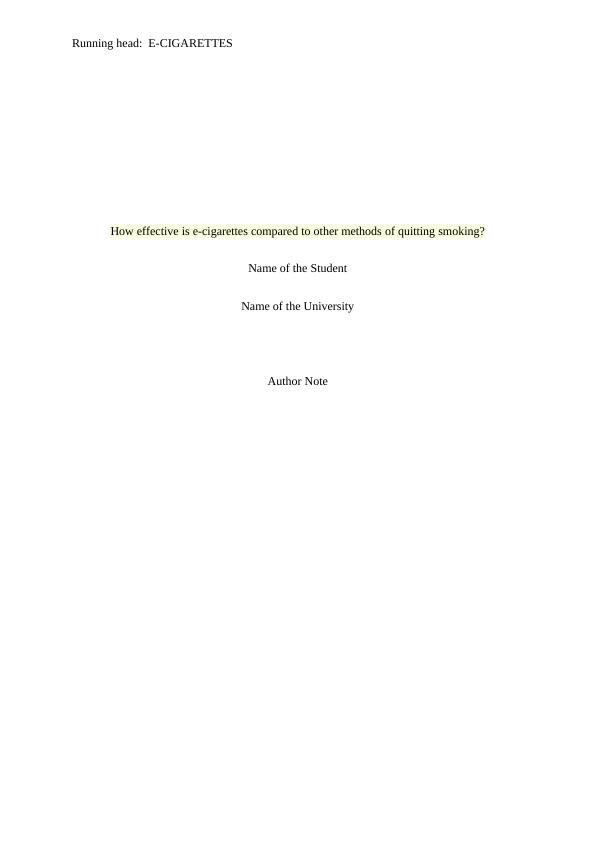
1E-CIGARETTES
Executive Summary
Smoking can be defined as an act of consumption of boring smoke coming out of tobacco,
wrapped in the form of cigarettes. This act of smoking is detrimental for health as it
responsible for several different kinds of health related fatal complications like cancer. Not
only active smoking, passive smoking is also associated with numerous health threats.
Children who are exposed to second hand smoke develop developmental defects, both mental
and physical. Thus, cessation of smoking is an urgent need in UK in order to reduce the
smoking related mortality and morbidity rate. The study here will follow a literature review
format in order to elucidate the effectiveness of E-cigarettes as an important medium of
smoking cessation. The study will also perform a comparative study between E-cigarettes and
other mediums which are used as substitutes for smoking in the process of smoking
withdrawals among the smokers. At the end, the study provides a recommendation in the
grounds of further approaches that are important to accelerate the smoking cessation rate in
UK.
Executive Summary
Smoking can be defined as an act of consumption of boring smoke coming out of tobacco,
wrapped in the form of cigarettes. This act of smoking is detrimental for health as it
responsible for several different kinds of health related fatal complications like cancer. Not
only active smoking, passive smoking is also associated with numerous health threats.
Children who are exposed to second hand smoke develop developmental defects, both mental
and physical. Thus, cessation of smoking is an urgent need in UK in order to reduce the
smoking related mortality and morbidity rate. The study here will follow a literature review
format in order to elucidate the effectiveness of E-cigarettes as an important medium of
smoking cessation. The study will also perform a comparative study between E-cigarettes and
other mediums which are used as substitutes for smoking in the process of smoking
withdrawals among the smokers. At the end, the study provides a recommendation in the
grounds of further approaches that are important to accelerate the smoking cessation rate in
UK.

2E-CIGARETTES
Table of Contents
Chapter 1: Introduction..............................................................................................................3
Chapter 2: How smoking affects the body?...............................................................................7
Exposure to second hand smoke............................................................................................7
Effect of smoking on young children.....................................................................................9
Effects of smoking on pregnant women and the unborn child.............................................10
Effects of smoking on individual health..............................................................................12
Effects of smoking on general public...................................................................................14
UK and Global Statistics of E-Cigarettes.................................................................................17
Mechanism of E-Cigarettes Action..........................................................................................19
Prevalence of Use of E-Cigarette.............................................................................................19
Laws and Policies of E-Cigarette.............................................................................................21
Chapter 3..................................................................................................................................30
Chapter 4: Interventions...........................................................................................................36
Preventative measures..........................................................................................................36
Smoking incentives and cessations......................................................................................40
Government Initiatives.........................................................................................................40
Chapter 5: Conclusion..............................................................................................................43
Recommendation for practice..............................................................................................43
Personal Reflection of the Study..........................................................................................44
References................................................................................................................................46
Table of Contents
Chapter 1: Introduction..............................................................................................................3
Chapter 2: How smoking affects the body?...............................................................................7
Exposure to second hand smoke............................................................................................7
Effect of smoking on young children.....................................................................................9
Effects of smoking on pregnant women and the unborn child.............................................10
Effects of smoking on individual health..............................................................................12
Effects of smoking on general public...................................................................................14
UK and Global Statistics of E-Cigarettes.................................................................................17
Mechanism of E-Cigarettes Action..........................................................................................19
Prevalence of Use of E-Cigarette.............................................................................................19
Laws and Policies of E-Cigarette.............................................................................................21
Chapter 3..................................................................................................................................30
Chapter 4: Interventions...........................................................................................................36
Preventative measures..........................................................................................................36
Smoking incentives and cessations......................................................................................40
Government Initiatives.........................................................................................................40
Chapter 5: Conclusion..............................................................................................................43
Recommendation for practice..............................................................................................43
Personal Reflection of the Study..........................................................................................44
References................................................................................................................................46
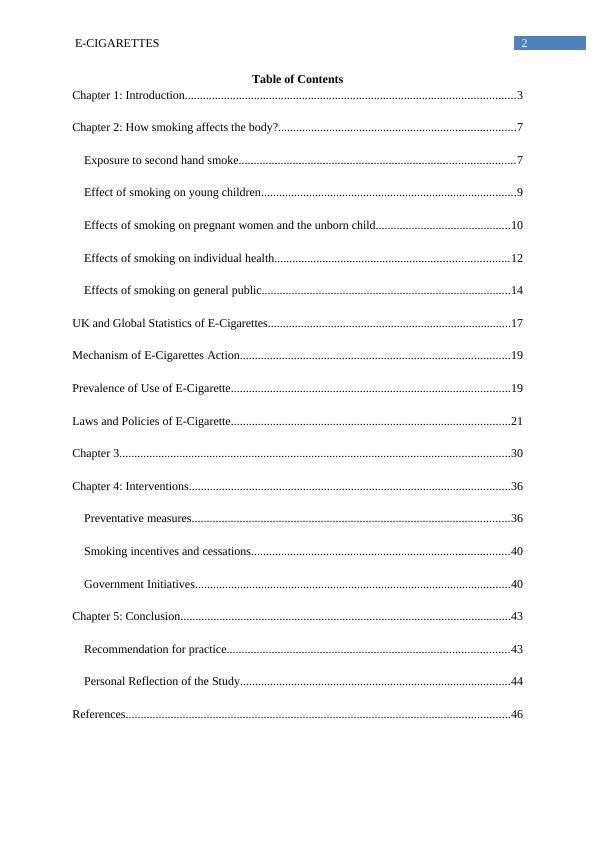
3E-CIGARETTES
Chapter 1: Introduction
Smoking is defined as the act of inhalation of the burning tobacco contained in cigars
and cigarettes where the resulting smoke is inhaled and absorbed into the bloodstream
(Brown et al. 2014). Smoking is regarded by health experts as psychological addiction and
involves adverse health consequences (Dinas et al. 2013). There are different types of
smoking that are light, very light, occasional, and never daily smoking (Hurley 2014). Light
smoking is also known as intermittent smoking and is defined as, denied smoking in past
month and denied smoking in regular fashion (Shiffman et al. 2014). In this type of smoking
an individual consumes 1–4 g of tobacco per day (Hurley 2014). Very light smoking is
defined as consistent smoking with less than 5 cigarettes smoked per day (Kvaavik et al.
2014). Occasional smoking is defined as nondaily smoking which means not a regular
smoking (Kvaavik et al. 2014). Never daily smoking is defined as no smoking daily for last
six months or more and no regular smoking (Park and June 2006). As per the literature there
are different stages models for smoking definitions. In addition, there are smoking trajectories
and statistics to smoking definitions (Pirie et al. 2013). In many literatures there are no
differentiations of various level of smoking apart from Action on Smoking and Health
(Eastwood et al. 2015).
Smoking is highly prevalent in the world as per the Global Health Observatory data.
In 2015, more than 1.1 billion people smoked tobacco (WHO 2017). The number of men
smoking was more than women (WHO 2017). However, it was found to decline in many
parts of the world. The prevalence was found to increase in the WHO African and
Mediterranean region (WHO 2017). In 2015, 17.2% of all the adults smoked in UK (Pirie et
al. 2013). Currently, the adults who smoke in England comprises are 16.9%, Scotland,
19.2%, Northern Ireland 19.1%, and in Wales it was found to be 18.0% (Office for National
Statistics- UK. 2017). The men and women population smoking in UK slightly differed
Chapter 1: Introduction
Smoking is defined as the act of inhalation of the burning tobacco contained in cigars
and cigarettes where the resulting smoke is inhaled and absorbed into the bloodstream
(Brown et al. 2014). Smoking is regarded by health experts as psychological addiction and
involves adverse health consequences (Dinas et al. 2013). There are different types of
smoking that are light, very light, occasional, and never daily smoking (Hurley 2014). Light
smoking is also known as intermittent smoking and is defined as, denied smoking in past
month and denied smoking in regular fashion (Shiffman et al. 2014). In this type of smoking
an individual consumes 1–4 g of tobacco per day (Hurley 2014). Very light smoking is
defined as consistent smoking with less than 5 cigarettes smoked per day (Kvaavik et al.
2014). Occasional smoking is defined as nondaily smoking which means not a regular
smoking (Kvaavik et al. 2014). Never daily smoking is defined as no smoking daily for last
six months or more and no regular smoking (Park and June 2006). As per the literature there
are different stages models for smoking definitions. In addition, there are smoking trajectories
and statistics to smoking definitions (Pirie et al. 2013). In many literatures there are no
differentiations of various level of smoking apart from Action on Smoking and Health
(Eastwood et al. 2015).
Smoking is highly prevalent in the world as per the Global Health Observatory data.
In 2015, more than 1.1 billion people smoked tobacco (WHO 2017). The number of men
smoking was more than women (WHO 2017). However, it was found to decline in many
parts of the world. The prevalence was found to increase in the WHO African and
Mediterranean region (WHO 2017). In 2015, 17.2% of all the adults smoked in UK (Pirie et
al. 2013). Currently, the adults who smoke in England comprises are 16.9%, Scotland,
19.2%, Northern Ireland 19.1%, and in Wales it was found to be 18.0% (Office for National
Statistics- UK. 2017). The men and women population smoking in UK slightly differed
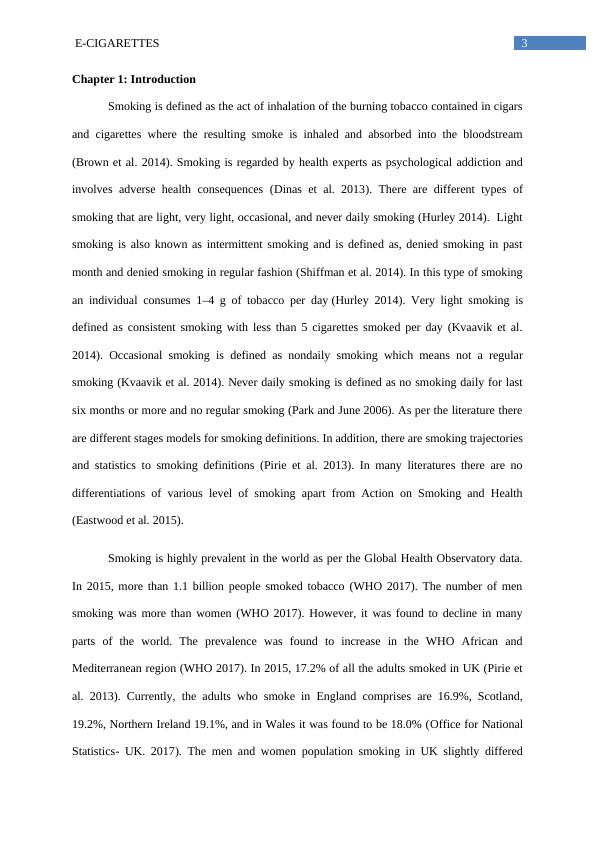
4E-CIGARETTES
(Peters et al. 2014). In 2015, UK men smoking percentage was 19.3% when compared to
women smoking per compared to 15.3% (Pirie et al. 2013). In Great Britain, the prevalence
of smoking is high among the population group earning less than £10,000 per year along with
the groups looking forward to work (Brown et al. 2014). As observed in 2016-2017 near
about 9 million adults in UK smoke cigarettes. Two thirds of smokers in UK has been found
to initiate smoking before 18 years of age (ash.org.uk 2017).
In reference to the current smokers, around half of them have used e-cigarettes. Those
using the e-cigarettes comprise 14.4% of the current smokers (Bauld et al. 2015). In 2015, e-
cigarettes was used by 2.3 million people n Great Britain. Half of this people use “Vapping”
as a means to quit smoking (Office for National Statistics 2017). Evidence has been found
that the smoking prevalence in UK is decreasing since last decade. Adults who smoke in UK
was 20.1% in 2010 (Bauld et al. 2015). The statistics of 2010 and 2015 shows notable
differences. Across all ages in UK smoking has become less common from 2010 to 2015
(Dinas et al. 2013). A significant difference has been noted in the age group 18-24 years in
UK (Vardavas et al. 2015). Since 1974 the lowest level of smoking each day in Britain was
found to be 11.3 cigarettes (Gilmore et al. 2014). In this place the highest proportion of
quitters since 1974 was 56.7% of all adults as observed in 2016 (Gilmore et al. 2014).
World Health Organisation or WHO reports that 600,000 people are estimated to die
due to second hand smoke. Currently, the data across the world states that smoking as per
WHO is responsible for 6 million deaths (www.who.int 2017). Smoking has negative health
effects. Smoking hampers various physiologic processes mainly respiration (Eastwood et al.
2015). In England, cardiovascular disease due to smoking is very prominent and has caused
one third of deaths in 2015 (Pujades-Rodriguez et al. 2014). Half of the long term smokers
have been killed due to tobacco smoking in comparison to the average mortality rate of non-
smokers. From 1990 to 2015 smoking resulted in 5 million deaths per year (Ons.gov.uk
(Peters et al. 2014). In 2015, UK men smoking percentage was 19.3% when compared to
women smoking per compared to 15.3% (Pirie et al. 2013). In Great Britain, the prevalence
of smoking is high among the population group earning less than £10,000 per year along with
the groups looking forward to work (Brown et al. 2014). As observed in 2016-2017 near
about 9 million adults in UK smoke cigarettes. Two thirds of smokers in UK has been found
to initiate smoking before 18 years of age (ash.org.uk 2017).
In reference to the current smokers, around half of them have used e-cigarettes. Those
using the e-cigarettes comprise 14.4% of the current smokers (Bauld et al. 2015). In 2015, e-
cigarettes was used by 2.3 million people n Great Britain. Half of this people use “Vapping”
as a means to quit smoking (Office for National Statistics 2017). Evidence has been found
that the smoking prevalence in UK is decreasing since last decade. Adults who smoke in UK
was 20.1% in 2010 (Bauld et al. 2015). The statistics of 2010 and 2015 shows notable
differences. Across all ages in UK smoking has become less common from 2010 to 2015
(Dinas et al. 2013). A significant difference has been noted in the age group 18-24 years in
UK (Vardavas et al. 2015). Since 1974 the lowest level of smoking each day in Britain was
found to be 11.3 cigarettes (Gilmore et al. 2014). In this place the highest proportion of
quitters since 1974 was 56.7% of all adults as observed in 2016 (Gilmore et al. 2014).
World Health Organisation or WHO reports that 600,000 people are estimated to die
due to second hand smoke. Currently, the data across the world states that smoking as per
WHO is responsible for 6 million deaths (www.who.int 2017). Smoking has negative health
effects. Smoking hampers various physiologic processes mainly respiration (Eastwood et al.
2015). In England, cardiovascular disease due to smoking is very prominent and has caused
one third of deaths in 2015 (Pujades-Rodriguez et al. 2014). Half of the long term smokers
have been killed due to tobacco smoking in comparison to the average mortality rate of non-
smokers. From 1990 to 2015 smoking resulted in 5 million deaths per year (Ons.gov.uk
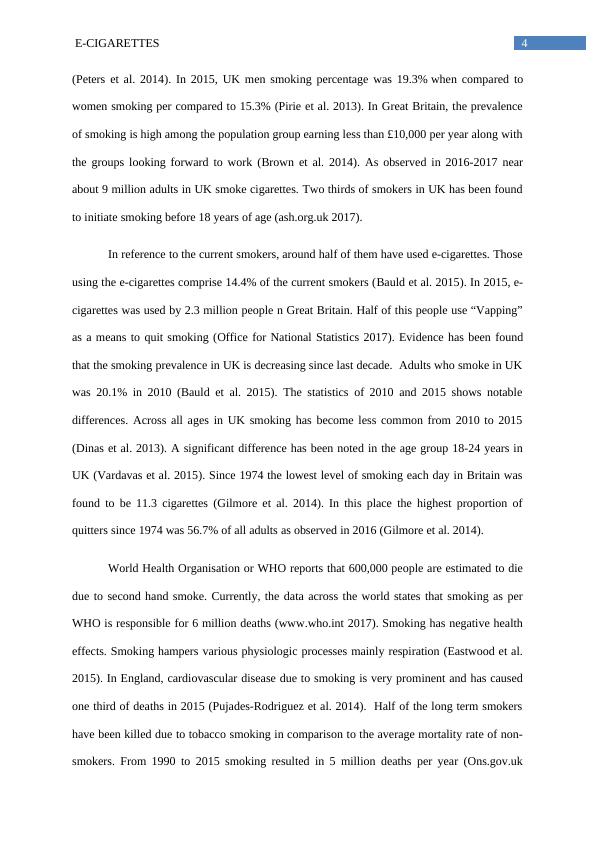
5E-CIGARETTES
2017). Smoking causes lung cancer and is responsible for 80% of death (Ons.gov.uk 2017).
Smoking causes around 80% of death from emphysema, and bronchitis and 14% due to heart
disease (Office of National Statistics UK 2017). According to Eastwood et al. (2015),
Smoking causes cancer and quarter of all deaths due to it. Smoking is the preventable
addiction and is avoidable risk factors for breast cancer (Dossus et al. 2014). It is estimated
that one in four people with smoking habit will die out of cancer (Pirie et al. 2013). It is the
factor contributing to decreased fertility and sexual function in both men and women (WHO
2017). It also leads to adverse health effects in pregnant women and unborn child (Forman et
al. 2017). Smoking according to Lê Cook et al. (2014) is also associated with poor mental
health. Both passive and active smoking has been found to share a relationship behind the
cause of development of Meningococcal disease. Smoking is also the risk factor for dementia
in later stages of life. It is also a major risk factor for diabetes and in many cases has been
found to cause premature death (Office of National Statistics UK 2017). In addition to health
problems, smoking also causes other problems. Smoking is associated with too many health
consequences, that it affects the economy. It increases the cost burden of National Health
Service (NHS). It costs NHS around £2 billion a year for treating smoking associated
diseases (Guest et al. 2015). Taxation consists of 80% of the price of the cigarette pack (Xu
et al. 2015).
As per the literature review, there are many evidenced base strategies that can help
people overcome the smoking addiction. There are many health benefits of not smoking
which starts immediately after the quitting (WHO 2017). However, this process includes
combination of pharmacological and non-pharmacological approach. Behavioural support
and cognitive enhancement from the healthcare providers have been found to significantly
increase the chances of successful quitting (Stead et al. 2015). According to Stead et al.
(2015) effective pharmacotherapies are available that will help in smoking cessation. The
2017). Smoking causes lung cancer and is responsible for 80% of death (Ons.gov.uk 2017).
Smoking causes around 80% of death from emphysema, and bronchitis and 14% due to heart
disease (Office of National Statistics UK 2017). According to Eastwood et al. (2015),
Smoking causes cancer and quarter of all deaths due to it. Smoking is the preventable
addiction and is avoidable risk factors for breast cancer (Dossus et al. 2014). It is estimated
that one in four people with smoking habit will die out of cancer (Pirie et al. 2013). It is the
factor contributing to decreased fertility and sexual function in both men and women (WHO
2017). It also leads to adverse health effects in pregnant women and unborn child (Forman et
al. 2017). Smoking according to Lê Cook et al. (2014) is also associated with poor mental
health. Both passive and active smoking has been found to share a relationship behind the
cause of development of Meningococcal disease. Smoking is also the risk factor for dementia
in later stages of life. It is also a major risk factor for diabetes and in many cases has been
found to cause premature death (Office of National Statistics UK 2017). In addition to health
problems, smoking also causes other problems. Smoking is associated with too many health
consequences, that it affects the economy. It increases the cost burden of National Health
Service (NHS). It costs NHS around £2 billion a year for treating smoking associated
diseases (Guest et al. 2015). Taxation consists of 80% of the price of the cigarette pack (Xu
et al. 2015).
As per the literature review, there are many evidenced base strategies that can help
people overcome the smoking addiction. There are many health benefits of not smoking
which starts immediately after the quitting (WHO 2017). However, this process includes
combination of pharmacological and non-pharmacological approach. Behavioural support
and cognitive enhancement from the healthcare providers have been found to significantly
increase the chances of successful quitting (Stead et al. 2015). According to Stead et al.
(2015) effective pharmacotherapies are available that will help in smoking cessation. The
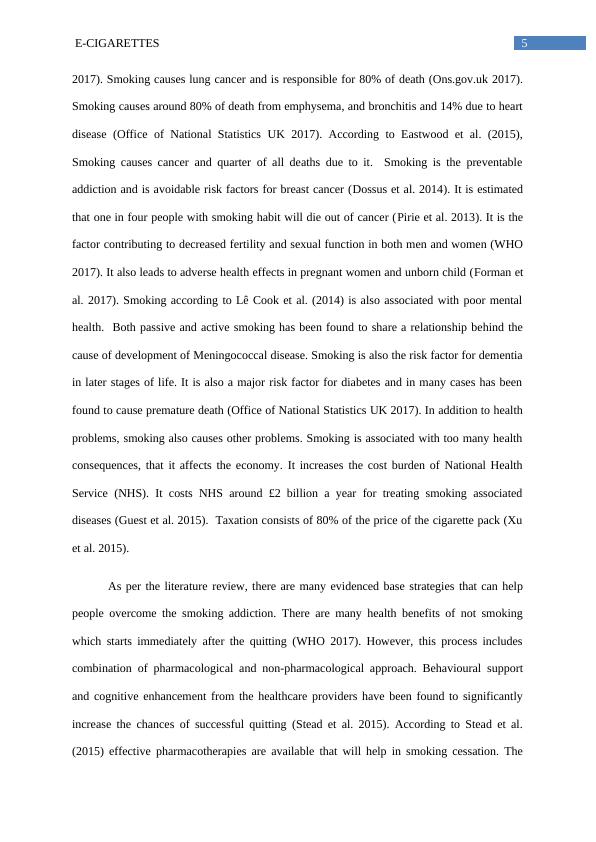
6E-CIGARETTES
effect may be small but is important as per various randomized control trials and meta-
analysis.
Keeping the rise in the number of smoking related casualties in Europe and round the
world, there must remain an effective intervention (Vardavas, Filippidis and Agaku 2015). At
present e-cigarette are employed as an effective substitute for the prevention of cigarette
addiction (Vardavas, Filippidis and Agaku 2015). E-cigarettes have potential to cut-down the
rate of smoking among the adult smokers how are not pregnant. It must be used as a complete
substitute for regular cigarettes or other smoked tobacco products. However FDA has still not
approved the use of E-cigarettes as a quit-smoking kit. This is due to the fact that E-cigarette
has nicotine, which imposes significant threats towards health. Scientists are still learning
about the long-term health effects of e-cigarettes (Centre of Disease Development 2017).
The current study aims to elucidate the effectiveness of E-cigarettes as an important
medium of smoking cessation (Chapman and Wu 2014). The study also aims to throw a brief
light over the comparative study with E-cigarettes and other mediums which are used as
substitutes for smoking in the process of smoking withdrawals among the smokers.
In order to elucidate the effectiveness of the E-cigarette in quitting smoking, the study
first initiate with discussing the ill-effects of smoking in chapter 2. The study then turns its
track on the burden of the smoking and its effects on socio-economy as discussed in chapter 3
with reference to hospital admission. Chapter 4 is the main portion of the study. It aims to
discuss the intervention or the preventative measures that are used to control smoking. Here
detailed insight is given over the use of E-cigarettes. The study also throws light on the
governmental policies prevalent in UK in relation to smoking and cessation. Finally in
Chapter 5 the study provides recommendation about the application of E-cigarette and sums
up with a reflective overview of the researcher on the research topic.
effect may be small but is important as per various randomized control trials and meta-
analysis.
Keeping the rise in the number of smoking related casualties in Europe and round the
world, there must remain an effective intervention (Vardavas, Filippidis and Agaku 2015). At
present e-cigarette are employed as an effective substitute for the prevention of cigarette
addiction (Vardavas, Filippidis and Agaku 2015). E-cigarettes have potential to cut-down the
rate of smoking among the adult smokers how are not pregnant. It must be used as a complete
substitute for regular cigarettes or other smoked tobacco products. However FDA has still not
approved the use of E-cigarettes as a quit-smoking kit. This is due to the fact that E-cigarette
has nicotine, which imposes significant threats towards health. Scientists are still learning
about the long-term health effects of e-cigarettes (Centre of Disease Development 2017).
The current study aims to elucidate the effectiveness of E-cigarettes as an important
medium of smoking cessation (Chapman and Wu 2014). The study also aims to throw a brief
light over the comparative study with E-cigarettes and other mediums which are used as
substitutes for smoking in the process of smoking withdrawals among the smokers.
In order to elucidate the effectiveness of the E-cigarette in quitting smoking, the study
first initiate with discussing the ill-effects of smoking in chapter 2. The study then turns its
track on the burden of the smoking and its effects on socio-economy as discussed in chapter 3
with reference to hospital admission. Chapter 4 is the main portion of the study. It aims to
discuss the intervention or the preventative measures that are used to control smoking. Here
detailed insight is given over the use of E-cigarettes. The study also throws light on the
governmental policies prevalent in UK in relation to smoking and cessation. Finally in
Chapter 5 the study provides recommendation about the application of E-cigarette and sums
up with a reflective overview of the researcher on the research topic.
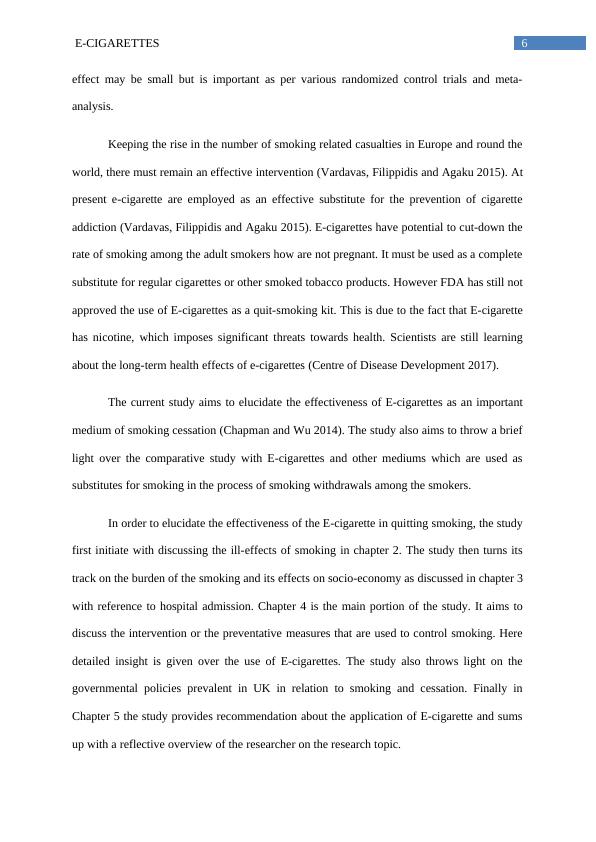
7E-CIGARETTES
Chapter 2: How smoking affects the body?
Exposure to second hand smoke
Second hand smoke can be referred to as the combination of the smoke coming out of
the cigarette and the smoke that comes out from a smoker (Rosen et al.2012). A non-smoker
in close proximity with a smoker can become the victim of passive smoking (Rosen et
al.2012). Exposure to second hand smoke can turn out to be as harmful as direct smoke. The
most detrimental effect of smoke is that it can retain in the air for several hours after
somebody had smoked (Rosen et al.2012).
Harmful effects of secondary smoke
Second hand smoke can pose serious health problems in the non smokers. According
to Islami, Torre and Jemal (2015) exposure to second hand smoke can enhance the chance of
lung cancer in the non smokers. Inhalation of secondary smoke is associated with increasing
risks of cardiovascular diseases (Islami, Torre and Jemal 2016). As stated by Vogl et al.
(2012) the non smokers victimized by the passive smoking have a higher rate of developing
health issues than those of the non smokers who have not got exposed to secondary smoke
(Burke et al. 2012). Exposure to second hand smoke may trigger obstructive respiratory
diseases and may cause huge respiratory distress in aged people (Islami, Torre and Jemal
2016). Breathing problems like wheezing, coughing, extra phlegm and shortness of breath are
some of the factors that maybe caused due to the exposure to second hand smoke (de Groot
and Munden 2012; Burke et al. 2012). Pregnant mothers who breathe in second hand smoke
can pose threat to the health of the babies (Simons et al., 2014). Second hand smoke can
trigger the asthmatic attack in people and may worsen the situation (Simons et al., 2014).
According to Rosen and his team of workers (2012), children who are more exposed
towards second hand smoke are likely to develop clinical conditions like bronchitis, ear
Chapter 2: How smoking affects the body?
Exposure to second hand smoke
Second hand smoke can be referred to as the combination of the smoke coming out of
the cigarette and the smoke that comes out from a smoker (Rosen et al.2012). A non-smoker
in close proximity with a smoker can become the victim of passive smoking (Rosen et
al.2012). Exposure to second hand smoke can turn out to be as harmful as direct smoke. The
most detrimental effect of smoke is that it can retain in the air for several hours after
somebody had smoked (Rosen et al.2012).
Harmful effects of secondary smoke
Second hand smoke can pose serious health problems in the non smokers. According
to Islami, Torre and Jemal (2015) exposure to second hand smoke can enhance the chance of
lung cancer in the non smokers. Inhalation of secondary smoke is associated with increasing
risks of cardiovascular diseases (Islami, Torre and Jemal 2016). As stated by Vogl et al.
(2012) the non smokers victimized by the passive smoking have a higher rate of developing
health issues than those of the non smokers who have not got exposed to secondary smoke
(Burke et al. 2012). Exposure to second hand smoke may trigger obstructive respiratory
diseases and may cause huge respiratory distress in aged people (Islami, Torre and Jemal
2016). Breathing problems like wheezing, coughing, extra phlegm and shortness of breath are
some of the factors that maybe caused due to the exposure to second hand smoke (de Groot
and Munden 2012; Burke et al. 2012). Pregnant mothers who breathe in second hand smoke
can pose threat to the health of the babies (Simons et al., 2014). Second hand smoke can
trigger the asthmatic attack in people and may worsen the situation (Simons et al., 2014).
According to Rosen and his team of workers (2012), children who are more exposed
towards second hand smoke are likely to develop clinical conditions like bronchitis, ear

End of preview
Want to access all the pages? Upload your documents or become a member.
Related Documents
Assignment On Damage From Cigarettelg...
|7
|1765
|19
Critical Appraisal of Evidence on Effectiveness of E-cigarettes for Smoking Cessationlg...
|9
|2160
|103
Article | Tobacco smoking refers to the process of inhaling smoke of tobacco that compriseslg...
|11
|1056
|16
Smoking Cessation Program for Schizophrenic Patients: Evidence-Based Nursing Researchlg...
|12
|3263
|161
Health Prevention Program : Smoking Cessationlg...
|1
|852
|27
Effectiveness of Lifestyle Modifications on Type 2 Diabetes Mellitus in Smoking Individuals Aged 45-60 Yearslg...
|68
|16967
|212
